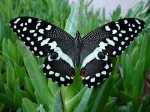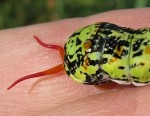 The Christmas butterfly is a swallowtail native to sub-Saharan Africa. It is also known as citrus butterfly because of the damage it does to citrus crops, and as orange dog because of the bright orange “horns” borne by the caterpillar. Christmas butterfly is found throughout Africa as well as in the southern part of the Arabian Peninsula, and is on a stamp from Mozambique.
The Christmas butterfly is a swallowtail native to sub-Saharan Africa. It is also known as citrus butterfly because of the damage it does to citrus crops, and as orange dog because of the bright orange “horns” borne by the caterpillar. Christmas butterfly is found throughout Africa as well as in the southern part of the Arabian Peninsula, and is on a stamp from Mozambique.
Although Christmas butterflies are swallowtails they lack the tail common to many of the genus. Both males and females are black with yellow bands. The hind wings have a large black and blue spot in the middle and a conspicuous black, blue and red eye spot on the back. The females may be a bit bigger than the males, but otherwise they appear very similar.
 Christmas butterflies go through a typical complete metamorphosis. Females lay their globular eggs singly on citrus leaves and after about six days the larvae hatch and begin feeding on the citrus leaves as well as the remains of the eggs. The immature larvae are black, yellow, and white and resemble bird droppings but in about a month mature into green caterpillars with pink or white spots and orange “horns“ that exude a foul smell that wards off predators. These caterpillars attach themselves to twigs with silk and become pupae for two to three weeks until they emerge as adults. This cycle may be repeated three times during the spring, summer, and fall of the year. The eggs may be parasitized by the parasitic wasps Ooencyrtus spp., and the pupae by parasitic wasps Pteromalus puparum.
Christmas butterflies go through a typical complete metamorphosis. Females lay their globular eggs singly on citrus leaves and after about six days the larvae hatch and begin feeding on the citrus leaves as well as the remains of the eggs. The immature larvae are black, yellow, and white and resemble bird droppings but in about a month mature into green caterpillars with pink or white spots and orange “horns“ that exude a foul smell that wards off predators. These caterpillars attach themselves to twigs with silk and become pupae for two to three weeks until they emerge as adults. This cycle may be repeated three times during the spring, summer, and fall of the year. The eggs may be parasitized by the parasitic wasps Ooencyrtus spp., and the pupae by parasitic wasps Pteromalus puparum.
